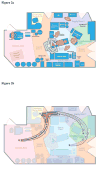Ambulatory movements, team dynamics and interactions during robot-assisted surgery
- PMID: 26800347
- PMCID: PMC5748883
- DOI: 10.1111/bju.13426
Ambulatory movements, team dynamics and interactions during robot-assisted surgery
Abstract
Objective: To analyse ambulatory movements and team dynamics during robot-assisted surgery (RAS), and to investigate whether congestion of the physical space associated with robotic technology led to workflow challenges or predisposed to errors and adverse events.
Methods: With institutional review board approval, we retrospectively reviewed 10 recorded robot-assisted radical prostatectomies in a single operating room (OR). The OR was divided into eight zones, and all movements were tracked and described in terms of start and end zones, duration, personnel and purpose. Movements were further classified into avoidable (can be eliminated/improved) and unavoidable (necessary for completion of the procedure).
Results: The mean operating time was 166 min, of which ambulation constituted 27 min (16%). A total of 2 896 ambulatory movements were identified (mean: 290 ambulatory movements/procedure). Most of the movements were procedure-related (31%), and were performed by the circulating nurse. We identified 11 main pathways in the OR; the heaviest traffic was between the circulating nurse zone, transit zone and supply-1 zone. A total of 50% of ambulatory movements were found to be avoidable.
Conclusion: More than half of the movements during RAS can be eliminated with an improved OR setting. More studies are needed to design an evidence-based OR layout that enhances access, workflow and patient safety.
Keywords: disruption; error; layout; operating time; robot; robotic surgery; surgical flow.
© 2016 The Authors BJU International © 2016 BJU International Published by John Wiley & Sons Ltd.
Conflict of interest statement
None disclosed.
Figures





References
-
- Wilson TG, et al. Best practices in robot-assisted radical cystectomy and urinary reconstruction: recommendations of the Pasadena Consensus Panel. Eur Urol. 2015;67(3):363–75. - PubMed
-
- Shouhed D, et al. Integrating human factors research and surgery: a review. Arch Surg. 2012;147(12):1141–6. - PubMed
-
- ElBardissi AW, Sundt TM. Human factors and operating room safety. Surg Clin North Am. 2012;92(1):21–35. - PubMed
-
- Cook RI, Woods DD. Adapting to new technology in the operating room. Hum Factors. 1996;38(4):593–613. - PubMed
-
- Cesarano FL, Piergeorge AR. The Spaghetti Syndrome. A new clinical entity. Crit Care Med. 1979;7(4):182–3. - PubMed
Publication types
MeSH terms
Grants and funding
LinkOut - more resources
Full Text Sources
Other Literature Sources

